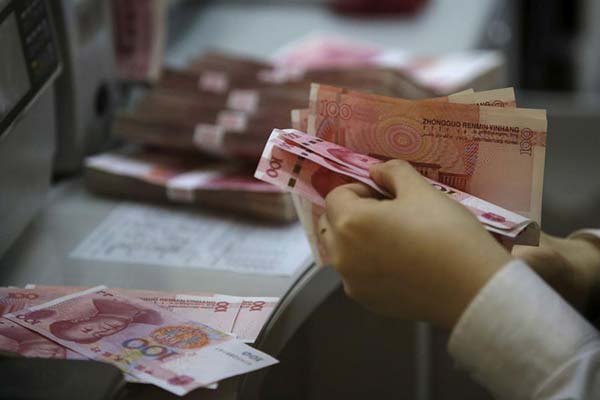China walks monetary tightrope as liquidity pressure mounts
 |
|
A clerk of the Industrial and Commercial Bank of China counts Chinese one hundred Yuan at its branch in Beijing.[Photo/Agencies] |
BEIJING - China's central bank is walking a tightrope between keeping enough liquidity to support market stability and deleveraging to avert financial risks.
The People's Bank of China (PBOC) injected 498 billion yuan ($73 billion) into the financial system via medium-term lending facility (MLF) on Tuesday, with the loans to mature in one year.
The move "sent a clear signal" of keeping liquidity "basically stable" by providing medium- and long-term funds to help the banking system through the mid-year strain, said Li Qilin, chief macro researcher with Lianxun Securities.
It followed another cash injection on Monday, when 30 billion yuan were put into the financial system through 28-day reverse repos, resuming the operation for the first time since May 16.
The moves are largely in response to spiking liquidity demand in the middle of the year due to seasonal factors such as regulatory reviews and tax payments. However, it has become quite tricky for China to manage liquidity in a stronger regulatory regime that has reduced the capital available on the money market.
On one hand, the PBOC needs enough liquidity to maintain financial stability and support the real economy; on the other, monetary policy cannot be too loose or the deleveraging process will falter, said Zeng Gang, an economist with the Chinese Academy of Social Sciences.
"The PBOC has to look after both sides," he said.
Interbank rates have been climbing over the past weeks. On Tuesday, the overnight Shanghai Interbank Offered Rate rose 2.52 basis points to 2.8419 percent. The rate for one-month loans increased 8.03 basis points to 4.3633 percent, the highest in more than two months.
Even with Tuesday's injection, liquidity remains strained as maturing MLFs will drain 430 billion yuan from the market in June.
In addition, the lingering possibility of US interest rate hikes may press the central bank to raise rates of open market operations, which will further weigh on liquidity, said Huang Wentao, an analyst with China Securities.
Despite the strain, the PBOC will maintain a "tight balance" in the money market as deleveraging remains the dominant task, Huang predicted.
"Although downward pressure in the economy has increased somewhat, it is still under control and will have little impact on monetary policy," he said.
China has set the tone of its 2017 monetary policy as prudent and neutral, keeping appropriate liquidity and avoiding excessive injections.
The PBOC is keen to avoid fluctuations in liquidity as its open market operations have become more transparent and flexible since the start of this year, said Zhou Guannan, analyst at Hua Chuang Securities.
The central bank has increasingly relied on various open market operations for liquidity management, rather than cuts in interest rates or reserve requirement ratios.
The MLF tool was first introduced in 2014 to help commercial and policy banks maintain liquidity by allowing them to borrow from the central bank by using securities as collateral.
In May, the PBOC injected 525.8 billion yuan into the market via MLF, standing lending facility and pledged supplementary lending.
















